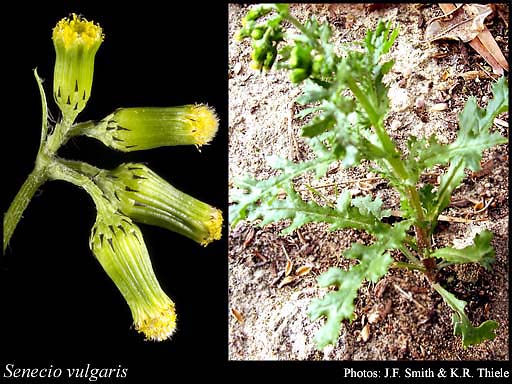- Reference
- Sp.Pl. 2:867 (1753)
- Conservation Code
- Not threatened
- Naturalised Status
- Alien to Western Australia
- Name Status
- Current
Erect, rather succulent annual, herb, 0.05-0.4(-0.75) m high. Fl. yellow, Jul to Dec or Jan to Feb. Sandy soils. Cultivated or disturbed grounds.

Distribution
- IBRA Regions
- Jarrah Forest, Swan Coastal Plain, Warren.
- IBRA Subregions
- Northern Jarrah Forest, Perth, Southern Jarrah Forest, Warren.
- IMCRA Regions
- WA South Coast.
- Local Government Areas (LGAs)
- Albany, Armadale, Cambridge, Cockburn, Dardanup, Fremantle, Gosnells, Joondalup, Manjimup, Melville, Mundaring, Nedlands, Perth, Rockingham, South Perth, Stirling, Swan, Wanneroo.
Management Notes (for the Swan NRM Region)
Alternative Names. Common Groundsel.
General Biology. Growth form. Herb. Life form. Annual. Reproduction. Seed. Dispersal. Wind, birds, clothing, fur, contaminated grain and cereal. Toxicity. All parts of the plant are poisonous to mammals, including humans. Seedbank persistence. 5 years.
Notes. Naturalised throughout the world and generally only persists in disturbed sites. Seeds are highly viable and can germinate throughout the year. Germination occurs under alternating light and dark conditions. Most seeds can germinate immediately and seedlings can emerge within a few days of seed shed. Seed produced in spring is generally more dormant than seed produced in summer or autumn. Seeds buried for 6 months in soil under natural conditions germinate readily on exposure to light. Can complete its life-cycle in 5-6 weeks but this may take longer on nutrient-rich soils. Resistant to some Group 5, 6 and 7 herbicides (including triazines, uracils and nitriles). A rust pathogen is currently being evaluated as a biocontrol agent in Europe.
Additional information. Origin. Northern Africa, temperate Asia.
Suggested method of management and control. Hand remove small/isolated populations. Apply Lontrel® at 10 ml/10 L + wetting agent before stem elongation in late spring. Read the manufacturers' labels and material safety data sheets before using herbicides. For further information consult the Australian Pesticides and Veterinary Medicines Authority to determine the status of permits for your situation or state.
Management Calendar
| Calendar Type | Jan | Feb | Mar | Apr | May | Jun | Jul | Aug | Sep | Oct | Nov | Dec | Comments |
|---|---|---|---|---|---|---|---|---|---|---|---|---|---|
| Germination | O | O | O | O | Y | Y | O | O | Y | Y | O | O | |
| Active Growth | O | Y | Y | Y | Y | Y | Y | ||||||
| Flowering | Y | Y | Y | Y | Y | Y | Y | Y | |||||
| Fruiting | Y | Y | Y | Y | Y | Y | Y | ||||||
| Manual Removal | O | O | O | O | O | Y | Y | Y | Y | O | O | O | |
| Herbicide Treatment | Y | Y | O |
Legend: Y = Yes, regularly, O = Occasionally, U = Uncertain, referred by others but not confirmed.
References
- Brown, K. & Brooks, K. (2002) Bushland Weeds: A Practical Guide to their Management. Environmental Weeds Action Network, Greenwood.
- Figueroa, R. (2003) Biology and management of common groundsel (Senecio vulagris L.) in strawberry. Ohio State University Dissertation.
- Figueroa, R., Doohan, D., Cardina, J. & Harrison, K. (2007) Common Groundsel (Senecio vulgaris) seed longevity and seedling emergence. Weed Science, 55 (3): 187-192.
- Frantzen, J., Rosii, F. & Muller-Scharer, H. (2002) Integration of biological control of common groundsel (Senecio vulgaris) and chemical control. Weed Science, 50: 787-793.
- Hedgerowmobile (Undated) Groundsel (Senecio vulgaris). Anon, United Kingdom. URL: http://hedgerowmobile.com/groundsel.html - Accessed July 2010.
- Hussey, B.M.J., Keighery, G.J., Dodd, J., Lloyd, S.G. & Cousens, R.D. (2007) Western Weeds. A guide to the weeds of Western Australia. 2nd Edition. The Plant Protection Society of Western Australia, Victoria Park.
- Kadereit, J.W. (1984) Studies on the biology of Senecio vulagris L. ssp. denticulatus (O.F.Muell.) P.D.Sell. New Phytologist, 97: 681-689.
- Lutman, P.J.W., Berry, K.J. & Freeman, S.E. (2008) Seed production and subsequent seed germination of Senecio vulgaris (groundsel) grown alone or in autumn-sown crops. Weed Research, 48: 237-247.
- Moore, C.B. & Moore, J.H. (2002) Herbiguide, the pesticide expert on a disk. Herbiguide, PO Box 44 Albany, Western Australia, 6330.
- Plants for a future (Undated) Plant Database. Plants For A Future, England and Wales. URL: http://www.pfaf.org/index.php - Accessed April 2010.
- Robinson, D.E., O'Donovan, J.T., Sharma, M.P., Doohan, D.J. & Figueroa, R. (2003) The biology of Canadian weeds. 123. Senecio vulgaris L. Canadian Journal of Plant Science, 83 (3): 629-644.
- Swarbrick, J.T. & Skarratt, D.B. (1994) The bushweed 2 database of environmental weeds in Australia. The University of Queensland, Gatton College.
- USDA, ARS, National Genetic Resources Program (2009) Germplasm Resources Information Network - (GRIN). National Germplasm Resources Laboratory, Beltsville, Maryland. URL: https://npgsweb.ars-grin.gov/gringlobal/taxon/taxonomysimple.aspx - Accessed October 2009.
- Weiner, J., Rosenmeier, L., Massoni, E.S., Vera, J.N., Plazam E.H. & Sebastià, M. (2009) Is reproductive allocation in Senecio vulgaris plastic. Botany, 87 (5): 475-481.